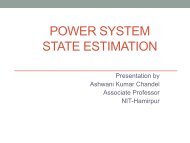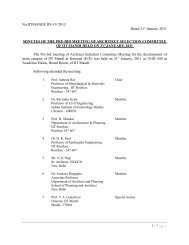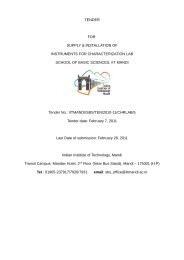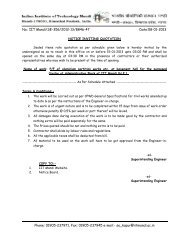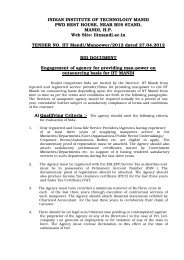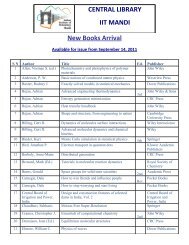ESSENT Society for Collaborative Research and Innovation, <strong>IIT</strong> <strong>Mandi</strong>meta-rationale for all the genuine interest whichthey displayed in Buddhism, Hinduism andother cultural and religious traditions of Asia.This European attitude towards the East, and thediscourses generated by it, has since beenfamously theorized by Edward Said in hisOrientalism. 4Any quest for antiquity and cultural identity willnaturally be concerned with the originality andauthenticity of the sources. This is very clearlyreflected in nineteenth century Europeanengagements with Buddhist literature too. Thegenuineness of texts was a major source ofconcern. Is a particular saying or sermonattributed to the Buddha really that of theBuddha? Or is it a later day interpolation? Doesthe meaning of a word or expression in Pali orSanskrit remain faithful to its etymologicalorigins? What is the real nature of change,which occurs when a Sanskrit word istransformed into Pali? What was the realintention of the author or compiler of a textwhen a particular word, phrase, sentence, orstanza was used? Such questions remained theprime concern of scholars from Burnouf to RhysDavids. This necessitated the production ofcritical editions of Pali and Sanskrit texts. Theseeditions contained extensive notes on variousaspects of the texts. Such notes were expected toauthenticate the genuineness and exposeinterpolations in both canonical and noncanonicalliterature. In other words, origin andauthenticity are the two major concerns, whichwe can identify as animating nineteenth centuryEuropean scholarship on Buddhist literature.This is not at all surprising; after all Europe wasdeeply concerned with its own historical andcultural roots, which it wanted to unearth inauthentic ways. 5origin and authenticity. Orientalist discoursepervaded most studies carried out under thisparadigm. This paradigm came into disuse onlyafter the fascination for historical and culturalorigins paved way for the discourse on racismand pure blood, leading to the advent of Fascismin Italy and Nazism in Germany, andculminating in the holocaust.References:1) According to some scholars, Buddhism wasnot a religion in the sense in which it isunderstood today. It came to be representedas a religion only in the nineteenth centuryas a result of academic, administrative andpopular British interest in it. This argumentis developed in Almond, Philip C. 1988.The British Discovery of Buddhism. NewYork and Cambridge: CambridgeUniversity Press.2) A textbook history of the Asiatic Society isfound in Mitra, S.K. 1974. The AsiaticSociety. Calcutta: The Asiatic Society.3) A history of academic interest in Buddhismin contained in Bhattacharya, N.N. 1981.History of Researches on India Buddhism.New Delhi: Munshiram Manoharlal. A briefoutline can be found in the first chapter ofBhattacharya, N.N. 1993. Buddhism in theHistory of Indian Ideas. New Delhi:Manohar.4) Said, Edward W. 1978. Orientalism. NewYork: Pantheon Books.5) It has also been argued that the translationsof Indian texts carried out in the colonial erawere part of deploying knowledge forexercising power over the colonizedsubjects. See Niranjana, Tejaswini. 1992.Siting Translation: History, Post-Structuralism, and the Colonial Context.Berkeley: University of California Press.This attitude continued well into the earlytwentieth century. Scholars like C.A.F RhysDavids (wife of T.W. Rhys David), JeanPrzyluski, Th. Stcherbatsky, Sylvain Levi, E.Obermiller, I.B. Horner, J.E. Carpenter, KarlSeidenstucker, Lord Chalmers, F.L. Wood Wardand many others continued to carry out researchfrom within the nineteenth century paradigm of62 ESSENT|Issue1|Vol1
ESSENT Society for Collaborative Research and Innovation, <strong>IIT</strong> <strong>Mandi</strong>An Overview ofMathematics andAstronomy in India(1300-1800 CE)Dr. Manu V. Devadevan, Assistant Professor,School of Humanities and Social Sciences,<strong>IIT</strong> <strong>Mandi</strong>Dr. Devadevan is a historian and a well knownwriter in Kannada. He is the author of severalbooks on history and literature. He has alsotranslated literary works from Kannada toEnglish and Malayalam as well as from Banglato Kannada. He specializes in the history of premodernSouth Asia. His areas of interest includepolitical and economic processes, pre-modernliterary practices and South Asian epigraphy.He is also a fellow of the Royal Asiatic Societyof Great Britain and Ireland.For much of the twentieth century, it wasbelieved that mathematics and astronomy inIndia ceased to make progress after the twelfthcentury and that Bhaskara II, the author ofLilavati, Bijaganita and Siddhanta Siromani,was the last great Indian mathematician andastronomer. All works, which appeared afterBhaskara II, were thought to be merecommentaries on earlier works, having nooriginal contributions to make. This was attimes associated with the parallel belief thatMuslim rulers turned a blind eye to the growthof science and technology, and hardly everpatronized the production of knowledge. Inputting forth these arguments, it wasconveniently forgotten that these disciplinesregistered no progress worth the name duringthe five odd centuries between the VedangaJyotisa (ca. 200-100 BCE) and the Bakhshalimanuscripts (ca. 300-400 CE), or that afterAryabhata I, Varahamihira, Bhaskara I andBrahmagupta (all between 475-600 CE), there isnearly two and a half centuries of silence beforewe meet the next prominent mathematicians,Mahavira and Sankaranarayana (both ca. 850CE).The situation is different today. The belief thatno significant mathematical treatise appeared inIndia after the twelfth century has been calledinto question, most notably by GeorgeGheverghese Joseph. 1 Joseph notes that “theperiod between the fourteenth and seventeenthcenturies marked a high point in the indigenousdevelopment of astronomy and mathematics”. 2But this he believes is a phenomenon restrictedonly to Kerala; “the picture about the rest ofIndia is somewhat patchy”. 3 What we see inKerala constitutes, according to Joseph, a KeralaSchool of Mathematics. 4We come across as many as eleven leadingmathematicians in Kerala between thefourteenth and the nineteenth century. 5 The lastof them was Sankaravarman (nineteenthcentury), who hailed from a princely family innorthern Malabar. His immediate predecessorwas Pudumana Somayaji (eighteenth century),63 ESSENT|Issue1|Vol1



